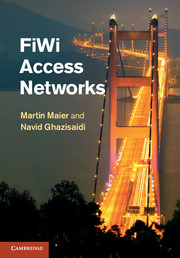Part IV - FiWi access networks
Published online by Cambridge University Press: 05 January 2012
Summary
Traditionally, wireless and optical fiber networks have been designed separately from each other. Wireless networks are aimed at meeting specific service requirements while coping with particular transmission impairments and optimizing the utilization of the system resources to ensure cost-effectiveness and satisfaction for the user. In optical networks, on the other hand, research efforts rather focused on cost reduction, simplicity, and future-proofness against legacy and emerging services and applications by means of optical transparency. Wireless and optical access networks can be thought of as complementary. Optical fiber does not go everywhere, but where it does go, it provides a huge amount of available bandwidth. Wireless access networks, on the other hand, potentially go almost everywhere, but provide a highly bandwidth-constrained transmission channel susceptible to a variety of impairments.
Future broadband access networks not only have to provide access to information when we need it, where we need it, and in whatever format we need it, but also, and arguably more importantly, have to bridge the digital divide and offer simplicity and user-friendliness based on open standards in order to stimulate the design of new applications and services. Toward this end, future broadband access networks must leverage on both optical and wireless technologies and converge them seamlessly, giving rise to fiber-wireless (FiWi) access networks (Aissa and Maier [2007]). FiWi access networks are instrumental in strengthening our information society while avoiding its digital divide.
Information
- Type
- Chapter
- Information
- FiWi Access Networks , pp. 111 - 116Publisher: Cambridge University PressPrint publication year: 2011
